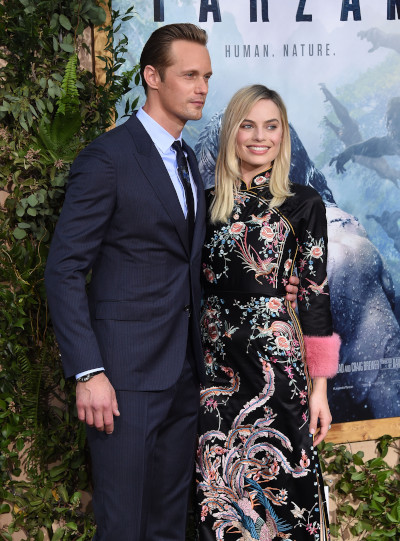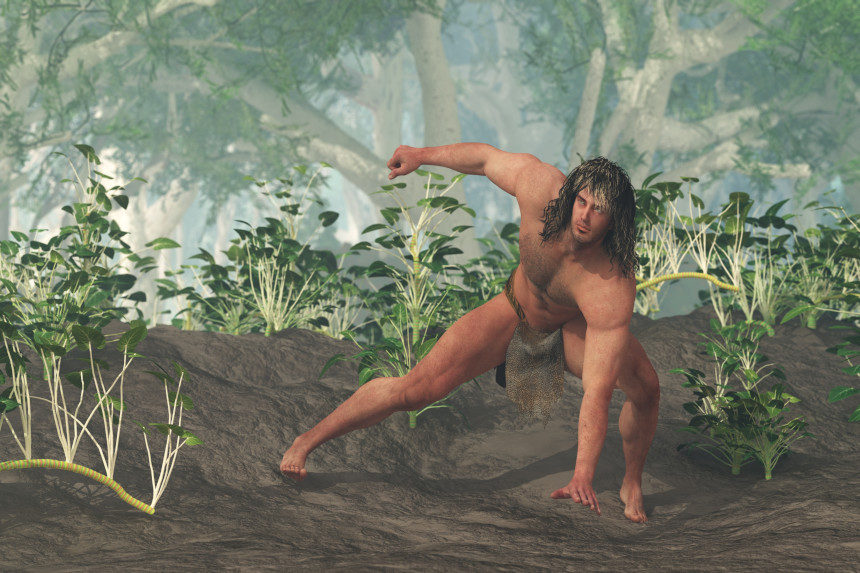When Tarzan, the Ape Man opened 40 years ago this week, it was widely regarded as perhaps the worst adaptation of the Edgar Rice Burroughs character. Burroughs himself began writing as a profession 110 years ago, and it wasn’t long before he introduced his two most famous characters, John Carter and Tarzan. While Burroughs’s racial and eugenicist views have received more examination and repudiation as the years have gone by, the strong adventure core of his stories has kept them popular. Tarzan in particular emerged to be one of the most famous characters in fiction, with an incredible number of adaptations over the decades. Here’s a look at the legend of the Lord of the Apes.
Born in 1875 in Chicago, Burroughs grew up to enlist in the 7th U.S. Cavalry, but was discharged in 1897 after being diagnosed with a heart condition. Burroughs held a number of jobs working ranches, prospecting for gold, and selling pencil sharpeners. After reading a number of stories in pulp magazines, Burroughs felt like he could write just as well as some of the writers he’d discovered. Though he started writing under the pseudonym Norman Bean, Burroughs would soon embrace the endeavor.
In early 1912, he published the first John Carter story, “Under the Moons of Mars,” in All-Story Magazine. John Carter is an Earthman who finds himself transported to Mars; stronger and faster in the lesser gravity of the Red Planet, Carter becomes a hero, romancing Red Martian Princess Dejah Thoris and becoming friends with the four-armed Green Martian warrior Tars Tarkas. The original serial would be published in novel form as A Princess of Mars; nine more and a short story collection followed.
However, the real break-out character for Burroughs was Tarzan of the Apes. Starting as an All-Story serial in the fall of 1912, Tarzan of the Apes displays most of the well-known bits of the character’s origin right from the beginning. Tarzan is really John Clayton II, heir to the title of the Earl of Greystoke. Shipwrecked in Africa with his parents, who soon die, the orphaned boy is raised by apes. Years later, he begins the journey of discovery about his own origins and eventually meets the love of his life, Jane Porter. These elements would become central to every version of the character, as would Tarzan’s almost supernatural athleticism, fighting prowess, and kinship with the animals.
A scene from Tarzan the Ape Man (Uploaded to YouTube by Warner Archive)
Tarzan became enormously popular. Burroughs made the character the star of 24 books, but his ambitions were grander than that. Tarzan was the first true transmedia character, meaning that Burroughs had ambitions to see Tarzan move into comic strips, film, and more. In short order, Burroughs made those ambitions into reality. The 1918 silent film Tarzan of the Apes was the first movie adaptation; it starred Elmo Lincoln. It was 1932’s Tarzan the Ape Man that made the character a true franchise player; with Johnny Weissmuller in the title role, it would be the first of 12 films starring the former Olympic swimmer. Tarzan the Ape Man also introduced one of the most popular facets of the character: the “Tarzan yell” or “call” which he generally used to summon animals to his aid.
Interestingly, due to rights divisions, there were movie serials starring other actors that were competing with the mainline Weissmuller films. Buster Crabbe, famous for playing both Flash Gordon and Buck Rogers in various serials, headlined the 12-part Tarzan the Fearless in 1933. Many of the earlier films and serials (including Weissmuller’s) sort of dumbed the character down into the familiar “Me Tarzan. You Jane,” stereotype. The Tarzan of the novels was partially self-educated, learning to read before he could speak, and later becoming multi-lingual. He was more intelligent and aristocratic. As the films went on, the screen Tarzan would evolve into something resembling this more well-rounded take on the character.
Tarzan feeds a Nazi to a lion in 1943’s Tarzan Triumphs (Uploaded to YouTube by Warner Archive)
While the films were enjoying success, Tarzan took to the radio as well. James Pierce played him from 1932 to 1936; another series with Lamont Johnson ran in the 1950s. A contemporaneous newspaper comic strip featured art by Hal Foster of Prince Valiant. Tarzan popped up in other comics, on Broadway (1921’s Tarzan of the Apes), and in whatever other media Burroughs could find. Tarzan was also an influence on another comic strip hero, Lee Falk’s The Phantom; Falk remixed elements of both Tarzan and Zorro for the masked crime-fighter’s origins.
For decades, Tarzan appeared regularly in a variety of films and TV series, including a 57-episode live-action series with Ron Ely from 1966 to 1968, until the character began to taper off in the 1970s. At that point, he found a home on animated television across several series produced by Filmation. Between 1976 and 1982, he appeared as a co-headliner in Filmation series alongside the likes of Zorro, the Lone Ranger, and Batman. Tarzan and the Super 7 (1978-1980) placed the character in an animated anthology alongside other heroes.
Trailer for Greystoke: The Legend of Tarzan, Lord of the Apes (Uploaded to YouTube by HudsonFilmLtd)
Since the 1980s, there has been at least one attempt at a live-action or animated Tarzan series in each decade. Tarzan has returned to the theater several times, although 1981’s Tarzan the Ape Man (mainly a vehicle to get Bo Derek’s Jane in various states of undress) and 1998’s Tarzan and the Lost City are considered poor attempts. The most interesting of the live-action swings was 1984’s Greystoke: The Legend of Tarzan, Lord of the Apes. Starring the future Highlander star Christopher Lambert as Tarzan and a young Andie McDowell (with her voice overdubbed by Glenn Close!), the movie was generally heavier, more serious, and more artistic than many of its predecessors. It had a decent performance at the box office and was nominated for three Oscars (Best Supporting Actor for Sir Ralph Richardson, Best Adapted Screenplay for Robert Towne and Michael Austin, and Best Makeup for Rick Baker and Paul Engelen).
Disney’s Tarzan trailer (Uploaded to YouTube by Movieclips Classic Trailers)
The most successful take in recent years (okay, more than 20), was Disney’s 1999 animated blockbuster, Tarzan. The film made just under $450 million dollars and scored an Oscar win for the Phil Collins tune, “You’ll Be in My Heart.” Disney made two direct-to-video sequels, a TV series, and a Broadway musical based on the film. 2016’s live-action The Legend of Tarzan, featuring Alexander Skarsgård in the title role and Margot Robbie as Jane, was a mid-sized hit with mixed reviews, but sequel talk seems to have faded.

So what is about Tarzan that continues to interest audiences? The core story of someone thriving in an unfamiliar and hostile environment, even becoming heroic, is the engine in a number of narratives. Weissmuller, already an Olympic champion when he took on the character, made him a familiar, courageous presence to movie audiences, and those films have lived on in popularity via countless airings on television ever since. Children probably like the idea that you could become pals with apes and elephants, whereas many adults likely recognize Tarzan as a comfortable presence from their youth. Even if the Ape Man isn’t as popular as he was in previous decades, Tarzan is still an important link in the evolutionary chain between the pulps and the action novels and films of today.
Featured image: Mike H / Shutterstock
Become a Saturday Evening Post member and enjoy unlimited access. Subscribe now




Comments
What a timely feature! I don’t go to McDonald’s very often, but while in Tarzana 2 days ago, stopped at the Wilbur & Ventura Blvd. location that’s heavy on classic Tarzan images adorning the walls. Then I see this the next day. I like most of the various incarnations of ‘Tarzan’ but the ones over the past 40 years not as much.
‘Tarzan the Ape Man’ was/is mainly appealing to me because of Bo Derek in various states of undress. She’s still a ’10’ all these years later, too. Margot Robbie, not so much. She was okay in that ABC series, ‘Pan Am’ about 10 years ago during the ‘Mad Men’ knock-off craze, but that’s about it. She’s found her calling as a crazy clodhopper in the ‘Suicide Squad’ films with the boots to match. Would be a good role for Gwyneth Paltrow, come to think of it.
Thanks for the links, Troy. Jim, your comments are totally right about how Tarzan combines the elements you mentioned.
Tarzan combines a group of major tropes, the little lost prince,(Arthur, Jesus), the feral child, (Romulus and Remus, Mogli), Rousseau’s Noble Savage and the perfect Victorian British Peer.